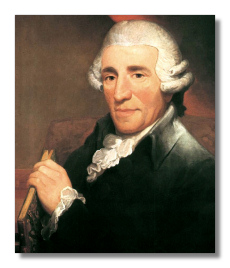The Classical Period (c.1750 - c.1830)
 The Baroque era witnessed the creation of a number of musical genres which would maintain a hold on composition for years to come, yet it was the Classical period which saw the introduction of a form which has dominated instrumental composition to the present day: sonata form. With it came the development of the modern concerto, symphony, sonata, trio and quartet to a new peak of structural and expressive refinement. If Baroque music is notable for its textural intricacy, then the Classical period is characterised by a near-obsession with structural clarity.
The Baroque era witnessed the creation of a number of musical genres which would maintain a hold on composition for years to come, yet it was the Classical period which saw the introduction of a form which has dominated instrumental composition to the present day: sonata form. With it came the development of the modern concerto, symphony, sonata, trio and quartet to a new peak of structural and expressive refinement. If Baroque music is notable for its textural intricacy, then the Classical period is characterised by a near-obsession with structural clarity.The seeds of the Classical age were sown by a number of composers such as Gluck, Boccherini and at least three of Johann Sebastian Bach's sons: Carl Phillip Emmanuel, Wilhelm Friedmann and Johann Christian (the so-called 'London' Bach). They were representative of a period which is variously described as rococo or galante, the former implying a gradual move away from the artifice of the High Baroque, the latter an entirely novel style based on symmetry and sensibility, which came to dominate the music of the latter half of the 18th century through two composers of extraordinary significance: Joseph Haydn and Wolfgang Amadeus Mozart.

Haydn was the major contributor to the evolution of Classical style, his most important contributions being the principle of thematic development and the integration into his style of a popular (even at times folklike) idiom capable of pleasing a wider audience. His London symphonies, composed from 1790 to 1795, represent the pinnacle of his instrumental art.
Let me give a little more details about what is considered a "classical" symphony. It is generally composed in four movement for orchestra, in a very typical 4-movement scheme:
1st movement: Allegro (sonata form) (fast-slow-fast)
2nd movement: Slow movement (ABA, variation form, etc.)
3rd movement: Scherzo or Minuet (ABA) (2nd and 3rd are interchangeable)
4th movement.: Fast movement (sonata, rondo, etc.)
Haydn became known for following a basic framework for his symphonies, which is also demonstrated by his Symphony no. 92 in G Major (Oxford). It starts with a slow introduction (a technique commonly found in Haydn’s symphonies) leading into a fast sonata-form first movement, followed then by a slower second movement, a minuet and trio, and lastly a faster finale. This became ‘the norm” and now serves as a template for the mature symphony.
Here is a very simple analysis this symphony:
- I. Adagio - Allegro spiritoso: Sonata-form
In the first movement, Haydn created contrasts between stability and instability to help listeners follow the form.
Exposition
Each thematic area in the exposition contains a variety of ideas.
Development
In the development, Haydn used a variety of techniques to manipulate motives from the exposition.
Recapitulation
Haydn sometimes disguised or played down the appearance of the recapitulation, which repeats all themes in the tonic (sometimes altered) and often amplifies the transition.
- II. Adagio cantabile: ABA form
In the second movement, Haydn usually offered songlike themes and simple forms to contrast with the drama and complexity of the first movement.
- III. Allegretto: Minuet and trio
The minuet and trio provided relaxation, since it was shorter than the second movement, was written in a more popular style, and was in a form that was easy to follow.
- Finale - Presto: Sonata-form
The final movement, usually in sonata form, rondo form, or sonata-rondo form, closes the symphony with a buildup of tension, a climax, and a release.
As you can hear bellow, Haydn was able to synthesize the Classical style and set new standards for the upcoming composers.
Nenhum comentário:
Postar um comentário